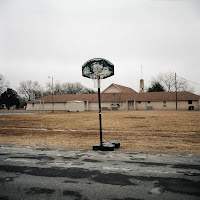Another piece of photography work i came across through twitter (it's becoming really rather useful actually) is the work of Casey Dunn. A set called 'Hoop Dreams' is a documentation of basketball hoops that have been left and abandoned, just like the chilhood dreams they represent.
Casey Dunn: "When I was 8 years old my dad came home with a fiber glass basketball goal and put it up in our backyard. After a couple of hours of grunting and swearing he tossed me a ball and said "shoot with your wrist" and walked inside. I spent hundreds of hours out there over the next ten years avoiding family functions and shooting hoops on that rim. I usually spent less time working on my game and more time daydreaming. Shooting hoops has always been my escape. As I started to travel a bit more, I started to notice more and more back yard goals that had fallen into disrepair the same way my childhood rim had. I loved the idea that some other kid had spent countless hours dreaming while shooting baskets the same way I did. This series is a collection of their basketball goals."
We've all had dreams when we were young kids about what we want to be when we grow up, and this set touches upon these 'goals'. Maybe they aren't so out of reach as we sometimes think, its just a case of dedication and persistence.
To me this work also makes a statement about the way the young generation are growing up in our society. When i was younger, i would have toys and games passed down to me from my siblings and cousins, and so i guess i'd expect that something permanent like these hoops would be passed down in the family and be in use by the children, yet maybe because society feels unsafe about letting their children play in the streets (for fear of attacks, kidnaps, bullying etc) they're sat inside infront of their video games? Maybe this work should make us question why this form of play is abandoned.




















